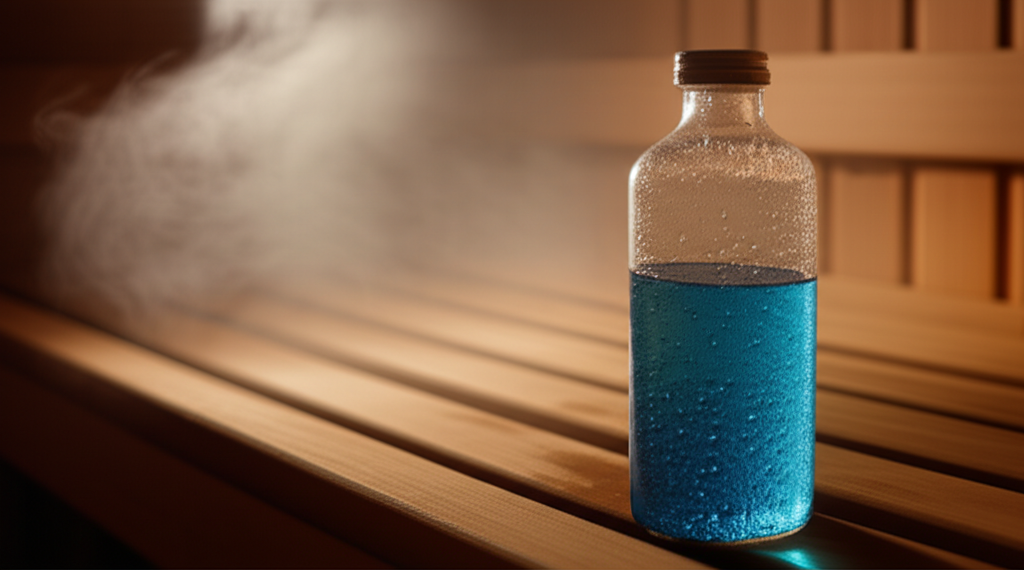• 10 min read
Sauna Hydration & Electrolytes: What Every Sauna Lover Needs to Know
Sweat loss in the sauna depletes both water and electrolytes—especially sodium. Learn research-backed strategies to hydrate smarter so you leave refreshed, not drained.

Key Takeaways
- Sauna sweat can reach ~1 liter every 20–30 minutes; most immediate weight loss is water.
- Sodium is the primary electrolyte lost; replacing only water can leave you depleted.
- Rehydrate within 30 minutes and prioritize a sodium-inclusive electrolyte solution.
- Smart hydration improves comfort, recovery, and habit consistency.
It’s Not Just Water – It’s Electrolytes
That post-sauna thirst isn’t just about water. Sweat contains a high concentration of sodium and chloride, plus smaller amounts of potassium, magnesium, and calcium. Sauna-induced sweating leads to measurable shifts in electrolytes, particularly sodium and chloride. In practical terms, average sweat contains roughly 800–1200 mg of sodium per liter — about 1 gram of salt lost per liter of sweat. Lose too much without replacing it and you’ll feel “low battery”: cramps, dizziness, headache, or overall fatigue.
Why Dehydration Wrecks Your Energy and Recovery
Fatigue and Brain Fog
Even mild dehydration can impair mood and cognition. Studies show losing as little as 1–2% body weight in water can reduce concentration and increase fatigue. If your “zen” turns into brain fog after a session, you likely need fluids and electrolytes.
Physical Performance and Recovery
Fluid loss reduces blood volume, forcing your heart to work harder and slowing recovery. Severe sweating without rehydration impairs both physical performance and cognition — hardly the outcome you want from a health routine.
Heat Stress and Safety
Proper hydration improves heat tolerance and lowers the risk of overheating. Experts advise rehydrating during and after deliberate heat exposure — ideally with electrolytes — because hot environments can disguise how much you’ve actually sweated.
Habit Sticking (Adherence)
If you routinely feel wiped out post-sauna, you’re less likely to keep the habit that yields long‑term benefits. Hydrating well turns sauna from draining to energizing — and keeps you coming back.
A Sodium‑First Approach to Sauna Hydration
Water is essential — but replacing sodium is the difference-maker. Drinking only water can dilute remaining electrolytes, and in rare cases contribute to hyponatremia. Rehydration works best when you match what you lost: roughly a liter of water plus ~1,000 mg sodium per liter is close to average sweat sodium.
Popular mixes like LMNT provide ~1000 mg sodium, ~200 mg potassium, and ~60 mg magnesium per packet with no sugar — essentially “sweat replacement in a stick.” DIY works too: add about 1/2 tsp sea salt (~1 g sodium) to a liter of water, squeeze in lemon, and include a small potassium source. Soda or coconut water alone won’t cut it for serious sweaters — they’re too low in sodium.
Practical Hydration Tips for Sauna Users
- Pre‑hydrate (not chug): Drink a glass of water 30–60 minutes before. Avoid caffeine/alcohol beforehand.
- Between rounds: Sip water with electrolytes. Aim to roughly match fluid intake with sweat loss.
- Right after: Rehydrate within 30 minutes. Start with ~500 mL cool water; add electrolytes to replace sodium, potassium, and magnesium.
- Prioritize sodium: Salty snack, broth, or electrolyte mix. Heavy sweat may require ~1000+ mg sodium over the first hour.
- Monitor: Urine color (aim for pale lemonade), energy, and any dizziness/headaches. Weigh pre/post if you like data: replace ~20–24 oz per lb lost over time.
Download The Sauna Hydration & Electrolyte Guide
We’ll expand this article into a full white paper soon. For now, grab the concise PDF with practical steps, templates, and checklists.
Want physician-aligned documentation for HSA/FSA? Start the pre‑screening to generate a doctor‑ready LMN draft in minutes.
References
The statements in this article are informed by peer‑reviewed research on sauna physiology and hydration, plus expert guidance from sources like Huberman Lab and hydration science resources. Selected links:
- Hydration prevalence and cognition: drinkhydrant.com
- Sweat rates and electrolyte loss summaries: science.drinklmnt.com
- Sauna physiology and performance: pmc.ncbi.nlm.nih.gov
- Practical sauna safety guidance: soothingcompany.com
- Expert heat exposure advice: hubermanlab.com